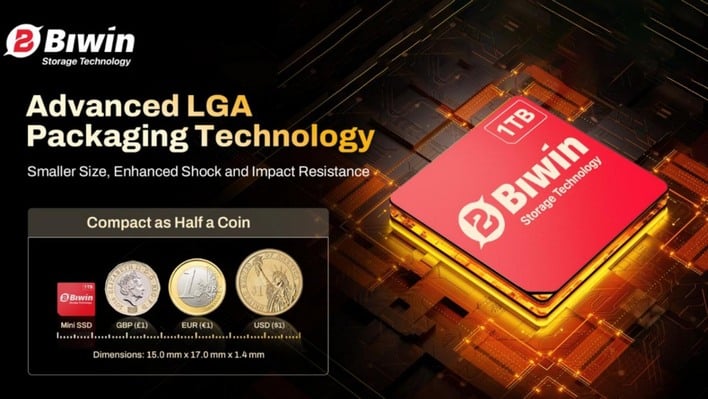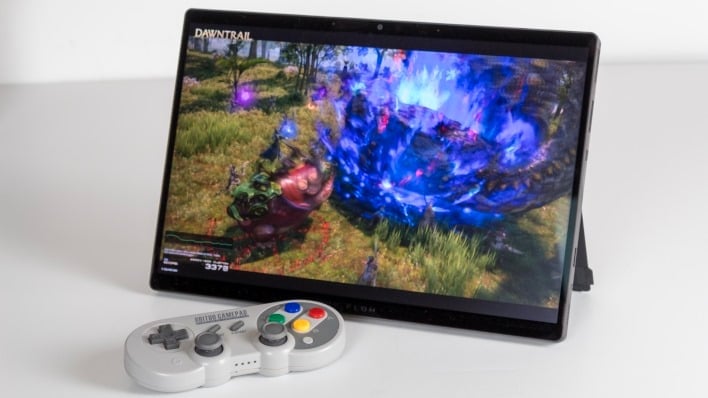GPD Win 5 Is A Strix Halo-Powered Gaming Handheld Rocking A Ryzen AI Max
GPD's video includes an RTSS-like overlay that shows "AI Max+ 395", "Radeon 8060s", and most critically, "CPU Power," which it lists as 57W. Running Black Myth Wukong, even on low settings as it is, at over 160 FPS using just 57W is very impressive, but typical gaming handhelds top out around 35W, which yields a power draw from the battery closer to 50W after you account for the screen, input, wireless, speakers, and so on. The idea of a handheld system that uses more than 70W to do its thing is kind of terrifying.
Supposedly the battery life won't be too bad, though. At least, that's according to ThePhawx, who posted a video on Friday (embedded below) sharing some information that he has about the new device. It's not clear where his information originates; he didn't explain, so we're going to assume these are simply rumors despite that his information is both plausible and also that he seems quite confident in most of the details.
So, according to the YouTuber, the GPD Win 5 includes a 7‑inch, 1080p, 120-Hz VRR display with FreeSync Premium support, 500 nits peak brightness, and Corning Glass 6 protection. He remarks that buyers will be able to configure the handheld with 32 GB, 64 GB, or 128 GB of quad‑channel LPDDR5X memory, which matches Strix Halo parts in other machines. He says that GPD will offer up to 4TB of PCIe 4.0 NVMe storage, although he also gets confused by the mention of "M.2 (Socket 3)", believing it to be a separate SSD slot.
Actually, "Socket 3" just describes M.2 key M, and seems to be talking about the primary SSD slot—but it also does seem like there's a second SSD socket in the GPD Win 5 for a "BIWIN Mini SSD," which is a curiously tiny storage device that uses a proprietary LGA socket. Biwin's SSD supports PCIe 4.0 x2, but apparently the GPD Win 5's Mini SSD socket only supports one lane of PCIe 4.0. MicroSD expansion is also on the list, of course. The rumored specs further mention surprisingly rich I/O for a handheld: USB 4 with DisplayPort 2.1 and PD charging, a second USB‑C 3.2, a full‑size USB‑A port, then then kicker: a barrel jack for 180W DC input, described as the primary charger.
One of the things that makes us most dubious on this device is that a mighty chip like Strix Halo needs massive cooling of a kind you don't normally find in handhelds. ThePhawx reports that the GPD Win 5 will come with a dual‑fan, quad-heat‑pipe cooling apparatus. He notes that in GPD's video, the Ryzen AI Max+ 395 stays at just 65°C while purportedly drawing around 55W. Of course, there's no sound in GPD's video, so we have no idea how loud the cooler is when pumping out >60W of heat.
The purported battery setup is even more unusual. ThePhawx claims that the GPD Win 5 features an external, clip‑on "backpack" battery pack rated at 80 Whr, the same as the battery on the ROG Ally X. Depending on load, battery life is estimated at 2 hours (heavy), 3–4 hours (moderate), and 6 hours (light use), which seems extremely implausible to us based on our handheld testing; we barely get that kind of battery life out of the Ally X, which uses a much smaller SoC. Your author expects it to be more like his childhood SEGA Game Gear, which could blow through six AA batteries in about 20 minutes flat.
For context: we reviewed the ASUS ROG Flow Z13 back in February, which also used the Ryzen AI Max+ 395 (16C/32T, 20 WGPs) with 32 GB of RAM. In CPU‑bound tasks, we found it competitive with AMD's Ryzen 9 9955HX "Fire Range" processor—essentially a Ryzen 9 9950X desktop chip adapted for laptops at 55 W. As a GPU, it performed broadly on par with a GeForce RTX 4070 Laptop at 1080p, though it slipped behind at 1440p thanks to memory bandwidth limitations. Even so, it was vastly faster than the Ryzen Z1 Extreme handhelds we've tested, like the ASUS ROG Ally X and Lenovo Legion Go.
With that said, the ROG Flow Z13 was sharply power‑ and thermally‑limited even at its max 80 W setting, and we can't help but wonder how a handheld like the Win 5 will fare when it's trying to cool the same silicon. Yes, the GPD video suggested that the 395 could hold 65°C at 60 W, but you're leaving a lot of performance on the table with Strix Halo at 55W. GPD's cooling solution sounds promising for a handheld, but it's still a handheld—there's only so much thermal mass to absorb and dissipate heat.
Still, we're cautiously optimistic. If GPD can balance power draw, thermals, and battery life even remotely well, the Win 5 could end up being the most awesome handheld we've ever seen. Pricing hasn't been confirmed, but ThePhawx speculated that the version with the top-end Ryzen AI Max+ 395 could land in the $1,500–$2,200 range, with the 385 model coming in a bit lower. We apparently don't have long to wait to see how it all shakes out; GPD says it will show the device at ChinaJoy 2025 this week, and ThePhawx claims that it'll launch in October—though given how these handheld launches tend to go, we don't expect to see it shipping until next year.





